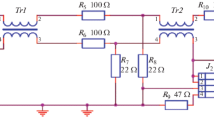Abstract
The article describes an electronically controlled a. c. operated d. c. interrupted are source for spectrographic analysis. The interrupted are source of otherwise conventional circuit can be ignited in a variable rhythm, i. e. the number of arcs per unit of time can be varied. The high voltage and high frequency ignition is done by means of a thyratron circuit with a Tesla transformer being inserted. The rhythm of the ignition can be adjusted by properly controlling the thyratron grid. The grid is controlled by voltage pulses coming from a pulse generator.
Резюме
В статье описывается служащий для спектрального анализа дуговой возбудитель постоянного тока с электронным управлением и с питанием от сети переменного тока: Прерывистый дуговой возбудитель, имеющий обычную схему, может зажигаться с переменным темпом, т. е. число дуг в единицу времени может быть изменено. Зажигание высокого напряжения и высокой частоты происходит при помощи тиратрона с использованием трансформатора Тесла. Темп зажигания устанавливается управлением сетки тиратрона. Сетка управляется импульсами тока, получаемыми от мультивибратора.
Similar content being viewed by others
References
Á. Bardócz, Interrupted Arc for Spectrum Analysis, Acta Physica Hungarica1, 247, 1952.
Á. Bardócz, Interrupted are source for spectrographic analysis (in Hungarian), Elektrotechnika44, 174, 1951.
K. Pfeilsticker, Der Abreissbogen mit Hochfrequenzzündung, Zs. Elektrochem.43, 719, 1937.
N. S. Sventitsky, Interrupted Arc for Spectral Analysis, Zavodskaya Lab.6, 325, 1937.
N. S. Sventitsky, Quantitative Spectrographic Analysis of Brass and Bronze, Zavodskaya Lab.7, 1371, 1938.
N. S. Sventitsky, Stabilization of A. C. Arc Used for Quantitative Spectrographic Analysis, Zavodskaya Lab.8, 470, 1940.
N. S. Sventitsky, A. C. Arc as a Light Source for Quantitative Spectrographic Analysis, Bull. Aced. Sci. USSR. Sér. Phys.5, 222, 1941.
N. S. Sventitsky, Present-day Sources of Light for Spectrographic Analysis, Bull. Acad. Sci. USSR. Sér. Phys.9, 677, 1945.
N. S. Sventitsky, The Steeloscope and its Applications (in Russian), Госугарственное издательство технико — теоретической литературы, Москва, Ленинград. 1948.
J. Calker, Über einige Erfahrungen bei spektralanalytischen Untersuchungen mit einem Abreissbogen begrenzter Bogenlänge, Zs. anorg. allg. Chemie234, 179, 1937.
W. Gerlach undW. Rollwagen, fortschritte in der spektralanalytischen Methodik, Metallwirtschaft16, 1083, 1937.
H. Hemmendinger, Time Effects and Arc Intensities, J. Opt. Soc. Am.32, 149, 1942.
J. L. Saunderson andV. J. Caldecourt, Accessory Equipment for Spectrochemical Analysis, J. Opt. Soc. Am.34, 116, 1944.
J. Mika, F. Macher andB. Vorsatz, Der Niederspannungsfunken als Lichtquelle der quantitativen Spektralanalyse, Anal. Chim. Acta3, 228, 1949.
T. Török, Spectrographic Analysis of Minor Constituents in Aluminium and its Alloys (in Hungarian), Magyar Kémiai Folyóirat,57, 196, 1951.
R. Schmidt, A normalized D. C. Interrupted Arc for Spectrochemical Analysis, Rec. Trav. Chim. Pays-Bas60, 378, 1941.
M. F. Hasler andH. W. Dietert, A New Spectroscopic Source Unit, J. Opt. Soc. Am.33, 218, 1943.
R. Schmidt andA. Schuringa, An Interrupted Direct Current Arc for Spectrochemical Analysis, Rec. Trav. Chim. Pays-Bas64, 349, 1945.
V. J. Caldecourt andJ. L. Saunderson, A Combination Arc-Spark Source for Magnesium Analysis, J. Opt. Soc. Am.36, 99, 1946.
The Dow Chemical Co., Magnesium Laboratory Methods, Spectrographic Analysis, 1946.
D. A. Sinclair, A Condensed Arc Source Unit for Spectrochemical Analysis, J. Opt. Soc. Am.38, 547, 1948.
W. Marti, Ein Generator für rechteckförmige, bogenähnliche Stromimpulse, Spectrochim. Acta4, 43, 1950.
Á. Bardócz, The Lighting Atoms and their Practical Uses (in Hungarian), Elektrotechnika33, 141 and 149, 1940;34, 129, 1941.
Carl Zeiss, Jena, Funkenerzeuger nach Feussner, Abreissbogengerät nach Pfelsticker, Mess. 264 B.
Carl Zeiss, Jena, Bedienungsanweisung für Funkenerzeuger nach Feussner Modell II, Abreissbogengerät nach Pfeilsticker Mess. 277/II.
Carl Zeiss, Jena, Funkenerzeuger nach Feussner, Abreissbogengerät nach Pfeilsticker, Mess 41–425.
Carl Zeiss—H. Kaiser, Anordnung zur funkenerzeugung für die Spektralanalyse, German patent No. 735 033, 1943.
J. H. Enns andR. A. Wolfe, An Air Interrupter Type Spectrographic Light Source, J. Opt. Soc. Am.39, 298, 1949.
A. Walsh, A General-Purpose Source Unit for the Spectrographic Analysis of Metals and Alloys, Bull. Brit. Non-Ferrous Met. Res. Assoc. No201, 60, 1946; Metal Industry68, 243, 264, 293, 1946.
A. Walsh, Spectrographic Analysis of Uranium, Spectrochim. Acta4, 47, 1950.
O. Findeisen, Abreissbogen nach Pfeilsticker, Zs. Metallkunde30, 213, 1938.
C. Braudo andH. R. Clayton, An Improved Spectrographic Source, J. Soc. Chem Ind.66, 259, 1947.
C. Braudo, J. D. Craggs andG. C. Williams, On the Excitation Temperature in a Spectroscopic Spark Source, Spectrochim. Acta3, 546, 1949.
The British Aluminium Co. Ltd., Analysis of Aluminium and its Alloys, 1949.
R. J. Dwyer, A Variable Frequency Electronic Interrupter for Direct Current Arc, J. Opt. Soc. Am.40, 180, 1950.
F. Kemmler, Anordnung zum Erzeugen elektrischer Bogenentladungen regelbarer Frequenz und Intensität für spektralanalytische Zwecke, German Patent No. 712 654, 1941.
Z. Nähring, Neuerungen auf dem Gebiet der Spektroanalyse, Messtechnik18, 113, 1943.
W. Meyer-Eppler andW. Koehler, Versuche an einem mit pulsierendem Gleichstrom betriebenen Abreissbogen, Arch. Elektrotechnik35, 603, 1941.
W. C. Heraeus—K. Pfeilsticker, Method and Apparatus for Spectrum Excitation, U. S. patent, No 2,212,950, 1938.
Carl Zeiss—H. Kaiser, Einrichtung zur Erzeugung eines Abreissbogens zur Spektralanalyse, German patent No. 699 052, 1940.
W. C. Heraeus—K. Pfeilsticker, Verfahren zum Anregen von Spektren, German patent No. 709 179, 1941.
Author information
Authors and Affiliations
Additional information
This paper forms part II of a series of articles, part I see reference [1].
Rights and permissions
About this article
Cite this article
Bardócz, Á. Investigations concerning light sources for spectrum analysis II. Acta Physica 2, 265–276 (1952). https://doi.org/10.1007/BF03156645
Received:
Issue Date:
DOI: https://doi.org/10.1007/BF03156645




